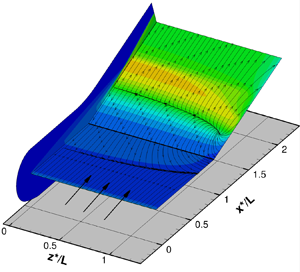Article contents
Wall temperature and bluntness effects on hypersonic laminar separation at a compression corner
Published online by Cambridge University Press: 02 July 2021
Abstract

This paper describes a numerical investigation on the effects of wall temperature and leading-edge bluntness on hypersonic laminar separation induced by a finite-span compression corner. The flow conditions were: Mach number 9.66; Reynolds number  $1.34 \times 10^6$ per metre; and stagnation temperature 3150 K. The wall to stagnation temperature ratio (
$1.34 \times 10^6$ per metre; and stagnation temperature 3150 K. The wall to stagnation temperature ratio ( $s_w$) varied from 0.095 to 0.333 and was thus in the subcritical range as per the classification of Brown et al. (J. Fluid Mech., vol. 220, 1990, pp. 309–337). Two leading-edge bluntnesses of
$s_w$) varied from 0.095 to 0.333 and was thus in the subcritical range as per the classification of Brown et al. (J. Fluid Mech., vol. 220, 1990, pp. 309–337). Two leading-edge bluntnesses of  $40\ \mathrm {\mu }\textrm {m}$ and
$40\ \mathrm {\mu }\textrm {m}$ and  $200\ \mathrm {\mu }\textrm {m}$ were used in the investigation. Numerical solutions were obtained using a compressible Navier–Stokes solver and compared with triple-deck solutions obtained using the numerical method of Cassel et al. (J. Fluid Mech., vol. 300, 1995, pp. 265–285). Separation was induced by ramp angles of
$200\ \mathrm {\mu }\textrm {m}$ were used in the investigation. Numerical solutions were obtained using a compressible Navier–Stokes solver and compared with triple-deck solutions obtained using the numerical method of Cassel et al. (J. Fluid Mech., vol. 300, 1995, pp. 265–285). Separation was induced by ramp angles of  $10^{\circ }$ and
$10^{\circ }$ and  $20^{\circ }$, which produced near incipient and large separations. The scaled angles, which increased with wall to stagnation temperature ratio, were not sufficient to induce secondary separation in the main recirculation region. Two regimes of shock interference were identified depending on the wall temperature ratio. The corner instability in the form of a stationary wave-packet identified by Cassel et al. (J. Fluid Mech., vol. 300, 1995, pp. 265–285) for scaled angles
$20^{\circ }$, which produced near incipient and large separations. The scaled angles, which increased with wall to stagnation temperature ratio, were not sufficient to induce secondary separation in the main recirculation region. Two regimes of shock interference were identified depending on the wall temperature ratio. The corner instability in the form of a stationary wave-packet identified by Cassel et al. (J. Fluid Mech., vol. 300, 1995, pp. 265–285) for scaled angles  $\alpha \geq 3.9$ was investigated but is shown to be a numerical artefact of the algorithm rather than having any physical basis. Increasing both the wall temperature ratio and blunting increased the separation length. And there is an equivalence between cooling the wall and reducing bluntness both leading to a reduced separation length.
$\alpha \geq 3.9$ was investigated but is shown to be a numerical artefact of the algorithm rather than having any physical basis. Increasing both the wall temperature ratio and blunting increased the separation length. And there is an equivalence between cooling the wall and reducing bluntness both leading to a reduced separation length.
Information
- Type
- JFM Papers
- Information
- Copyright
- © The Author(s), 2021. Published by Cambridge University Press
References
REFERENCES
- 13
- Cited by


